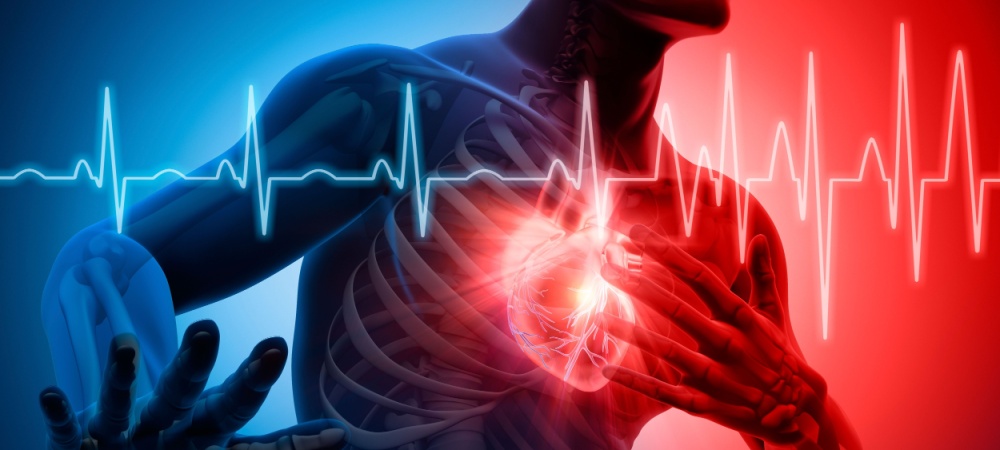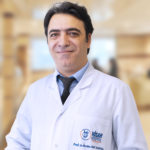What is a Heart Attack?
A heart attack, or “myocardial infarction (MI)”, is a cardiac problem that occurs when insufficient blood flows to the muscle layer of the heart called the myocardium. The blood flow to the heart muscles may decrease or completely stop. This condition may occur silently without showing any symptoms, or it may have severe symptoms. The underlying cause of a heart attack is often explained as coronary heart disease. Less commonly, coronary artery spasm may be responsible. In coronary artery disease, the arteries supplying the heart are blocked, and oxygen cannot reach the myocardium. Cell death begins in the heart muscle that is deprived of oxygen for a long time, and necrosis may develop. These effects can commonly manifest as pressure and discomfort in the chest, neck, shoulder, jaw, and arms. A heart attack can be diagnosed using blood tests, ECG, echocardiogram, angiogram, CT, and MRI methods. Medical intervention aims to restore blood flow as soon as possible. Initial heart attack intervention may involve medication, oxygen therapy, and surgery. The longer the time lost in ensuring blood flow, the more serious the damage to the heart muscle may be.
How Does a Heart Attack Occur?
Tissue death resulting from the decrease or interruption of blood flow to the myocardium, known as the heart muscle, can lead to a heart attack. Reduced blood flow is usually associated with the blockage of coronary arteries. Coronary arteries are the vessels that supply the heart and can become blocked due to various reasons. In cases of heart attack, one or more coronary arteries may be blocked. Plaque formation caused by atherosclerosis in the arteries is among the most common causes. The aggregation, sticking together, and accumulation of cholesterol, lipids, and other substances in the arteries can lead to plaque formation. Thrombus (blood clot) seen as a result of plaque formation and its settling in the artery indicates the process of atherosclerosis. In some cases, the plaque may rupture and turn into a clot that can block blood flow. The heart muscle in the area where blood flow is blocked may be damaged and die. Rapid intervention to restore blood flow to normal is vital. Permanent heart damage and death may occur if emergency intervention is not provided.
Why Does a Heart Attack Occur?
The most common cause of a heart attack can be considered coronary artery disease. Coronary artery disease, characterized by the blockage of one or more arteries, results from plaque formation. The resulting plaque layers can lead to the narrowing of the arteries and the slowing of blood flow. Not all heart attack cases may be caused solely by atherosclerosis blockages. Other possible causes of heart attack may include:
- Coronary artery spasm: This is an event that develops as a result of severe contractions in vessels without blockage. Early hardening or cholesterol plaques may be seen in these vessels.
- Coronary artery embolism: Characterized by a blood clot forming, circulating in the bloodstream, arriving at the heart, and blocking the coronary arteries.
- Spontaneous coronary artery dissection (SCAD): May result from tears formed inside the coronary arteries. Blood clots may form in these tears, or the torn tissue may cause the artery to become blocked.
- Infections: Certain viral infections (COVID-19, etc.) can damage heart muscles and arteries, potentially leaving permanent damage.
- Abnormal coronary arteries: A congenital abnormality in the structure or position of the coronary artery.
- Injuries or traumas that can lead to tears and ruptures in the coronary arteries may cause muscle necrosis.
Additionally, certain risk factors can also contribute to the development of a heart attack. These risk factors are often modifiable lifestyle habits. They can primarily be listed as follows:
- Smoking and alcohol consumption,
- Hypertension,
- High cholesterol and blood sugar,
- Obesity,
- High blood triglycerides,
- Physical inactivity,
- Aging,
- Stress,
- Use of addictive substances.
What Are the Symptoms of a Heart Attack?
Heart attack symptoms can be multiple and of varying severity. Individuals may have a heart attack even if they exhibit mild symptoms or no symptoms at all. Commonly seen heart attack symptoms may include:
- Pain, tightness, pressure in the middle-left side of the chest that lasts longer than a few minutes and recurs,
- Feeling exhausted and faint,
- Feeling pain and discomfort in one or both arms, shoulder, neck, back, jaw, or above the belly button,
- Shortness of breath while resting or during activity,
- Excessive and cold sweating without reason,
- Nausea and vomiting,
- Heartburn and indigestion,
- Sudden or normal dizziness,
- Irregular, rapid heartbeats,
- Sleep problems,
Most often, symptoms and warning signs may occur hours, days, or weeks in advance. These are signs that should be considered as pre-heart attack symptoms. Especially recurring chest pains that do not subside with rest may be the first symptoms of a heart attack. In some people, a sudden heart attack may occur. In this case, the first symptom is sudden cardiac arrest.
What Should Be Considered for a Heart Attack?
A heart attack can affect an individual’s heart rhythm and ability to pump blood. Heart muscles and vessels may also be damaged. The occurrence of a heart attack can be a significant risk factor for a new heart attack, kidney dysfunction, stroke, peripheral artery disease, and other health problems. For those who have had a heart attack, certain lifestyle changes and practices are important in preventing serious risks. Some of these include:
- Regulation of physical activity: Restrictions on exercise, business travel, sexual life, etc. may be required after a heart attack.
- Lifestyle habits: Ensuring an adequate and balanced diet, quitting smoking and alcohol consumption, resorting to stress management techniques, and having a physically active life can help protect cardiovascular health.
- Cardiac rehabilitation: A program recommended for people who have had a heart attack, heart failure, surgery, etc. These programs involve monitoring healthy eating, medication use, managing smoking habits, physical activity, and stress.
Additionally, ensuring the treatment and follow-up of existing other health problems may be recommended. Medical conditions such as hypertension, obesity, diabetes, and metabolic syndrome can also be direct or indirect risk factors for a heart attack.
Frequently Asked Questions
What is the Pulse Rate During a Heart Attack?
While there is no specific pulse value during a heart attack, generally, a risk is considered increased at a rate of over 80-100 beats per minute. This value can reach up to 200 and lead to life-threatening risks. However, a heart attack can also be asymptomatic.
What is the Troponin Level During a Heart Attack?
During a heart attack, troponin may not have a value that provides a definitive diagnosis. Troponin is a substance released into the blood when the heart is damaged, and different reference ranges may be used in laboratories. Normal values for Troponin I are 0-0.04 ng/mL, and normal values for Troponin T are 0-0.01 ng/mL.
How Long Does a Heart Attack Last?
Heart attack symptoms can be seen for a few minutes or hours. Generally, chest pain or discomfort are symptoms that last longer than a few minutes. However, symptoms can be mild and recur for several weeks.
What Triggers a Heart Attack?
Coronary artery disease and spasm, infections, spontaneous coronary artery dissection, coronary artery abnormalities, smoking and alcohol consumption, metabolic syndrome, high cholesterol and triglyceride levels, obesity, diabetes, drug use, and stress can be triggers for a heart attack.
What Prevents a Heart Attack?
There are preventable and unpreventable factors for a heart attack. Regular check-ups, regular physical activity, a healthy eating routine, quitting alcohol and smoking, maintaining an ideal weight, managing stress and depression, following up on other health problems, and using only medications prescribed by your doctor are important factors to consider in preventing a heart attack.
Is a Heart Attack Genetic?
Having a family history of heart attack can be among the risk factors for heart attack. Since genetics and lifestyle are similar among family members, the risk of heart attack may be high. If cardiac diseases are present in first-degree relatives under the age of 55-65 for women and men, the probability of a heart attack may be increased.
What Are the Symptoms of a Heart Attack at a Young Age?
Heart attack symptoms in young people are similar to those seen in other age groups. Therefore, a heart attack at a young age may manifest as pain or discomfort in the chest, shoulders, arms, neck, and jaw, shortness of breath, nausea and vomiting, sweating, irregular heartbeats, fainting or exhaustion, and sleep problems. Heart attack symptoms in the 20s can be mild or severe.
Is a Heart Attack Painful?
Heart attack symptoms can be mild in some cases, while they can be severe in others. Especially pressure and pain in the center-left chest, pain in the shoulder, jaw, neck, and shortness of breath can be painful. However, other underlying cardiac problems can also have some uncomfortable symptoms.
How Do We Know If We Have Had a Mild Heart Attack?
A mild or silent heart attack can be seen as mild tightness and discomfort in the chest, fatigue, indigestion, nausea, and mild pains in the arms, jaw, and upper back. Additionally, symptoms of a heart attack in women may include shortness of breath, sweating, and tingling in the jaw and arms.
What is a False Heart Attack?
“Broken heart syndrome”, known as a false heart attack, is a temporary heart condition that shows symptoms similar to a heart attack. It is usually the result of severe physical or emotional stress experienced during sudden illness, loss, accident, etc. Less chest pain is seen compared to a heart attack. Instead, symptoms of a false heart attack may include sudden fatigue, dizziness, cold sweats, and shortness of breath.
Do not neglect to take symptoms into account to protect your cardiovascular health.
For an expert evaluation of your heart attack risk, symptoms, or test results, you can make an appointment with our Hisar Hospital Cardiology specialists.
Early diagnosis saves lives! Take action for your health today.


